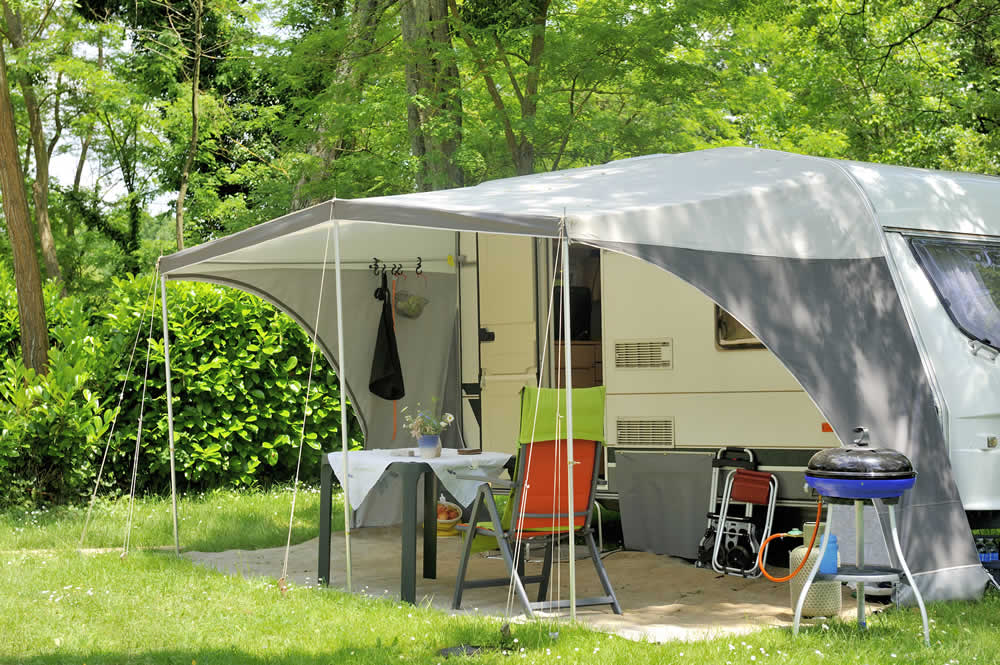Just as an extension or sunroom can give you extra space at home, so an awning can increase the space and comfort of your caravanning experience – at a fraction of the cost and without any building works at all.
An awning might double the covered ground area of your caravan pitch, giving you not only somewhere to dry out wet clothing and boots, but also a store for bikes or your water sports equipment.
Some awnings might even give you a room kitted out to sleep additional guests, a separate space for leisure and recreation, or a covered dining area. Indeed, they could serve all three functions at various times during the day.
The awnings available on the market today are all relatively easy to put up and take down. They’re lightweight and typically pack into a compact space for convenient storage and transport.
The different types of caravan awning
The awnings from which to choose also differ in design and function explains a guide published by the Camping and Caravanning Club, making them highly adaptable for use on practically any type of caravan:
Full awning
- this is the type of awning that fills the entire side of your caravan from front to back and, in doing so, is likely to double your floor area;
- they come in a range of different qualities and fabrics – and, rather like a tent, may have internal partitions for use as bedrooms, sides that can be lifted to let in the air on sunny days, and even “windows” with their own curtains;
- since it’s designed to cover the entire side of your caravan, this type of awning clearly needs to be measured and fitted according to the particular model of trailer you own – you cannot switch it from one caravan to another;
Porch awning
- these are sometimes called universal awnings because unlike the full awning they occupy only a part – though probably the major part – of the side of your caravan;
- the awning can be moved from one end of your caravan to the other, therefore, or – perhaps more importantly, can be taken with you for use with an alternative trailer if you subsequently decide to upgrade;
Canopy or cassette awning
- this variant relies on a box-like structure – the cassette – permanently fixed along the top edge of the caravan, with an awning that can be drawn out rather like a roller blind;
- there are typically foldaway legs at the corners of the canopy-like awning to add stability – and, in some cases, fabric walls that can be used to enclose the space covered by the canopy.
The awning you choose depends on the way in which it is likely to be used – and the Caravan and Motorhome Club suggests some of the questions you might want to ask yourself to help you decide.
The importance of insurance
Like any other valuable piece of caravanning kit, your awning also needs the protection of suitable insurance – awning insurance.
In many ways, though, the awning itself might be regarded as separate from the caravan itself. While your awning extends the useful ground area of your caravan pitch, it remains a separate extension – which can be dismantled entirely from the caravan – and is constructed from different materials.
The risks to which any awning is exposed are likely to differ substantially from those affecting the caravan itself – if you are caught out during storms on your caravanning holiday, for example, loss or damage is more likely to be suffered by your awning than the caravan.
Some – but not all – caravan insurance policies typically incorporate awning insurance as a separate part of your caravan insurance. And, because of the different nature and order of the risks to which any caravan awning may be exposed, it is important that you check your awning insurance is separately and specifically identified on your policy schedule.
As with the cover for the caravan itself and other pieces of valuable caravanning kit, the total sum insured for your awning has to be sufficient to cover the cost of repair – or replacement in the event of a total loss.
Keep records of your awning’s purchase, installation, and any maintenance performed. This documentation can be valuable if you need to file a claim as it provides evidence of the awning’s value and care.
Be aware of any policy exclusions
As with all insurance policies, do be aware of the policy exclusions typically associated with this type of cover.
An exclusion that is likely to have caught out many a caravan owner, for example, is loss or damage to an awning out of season while the caravan is laid up in your driveway or otherwise in storage.
Most awning insurance policies make clear that cover is in operation only when the caravan itself is in use – and cover may be excluded if you are away from the trailer for longer than a day or night or if you have already returned home and it is no longer being used. For example, storm damage to your awning may be excluded if you have left the awning up and are away from the caravan.
Some insurance policies might require you to perform regular maintenance on your awning to ensure its longevity and prevent avoidable damage. Failing to meet these maintenance requirements might affect your cover.
Also, do note that the contents of any awnings may not be covered under your caravan insurance policy, so do check with your insurance provider.
Summary
An awning is likely to prove an indispensable, versatile and highly adaptable piece of caravanning kit – that may well double the usable ground area at your caravan pitch.
Like any piece of valuable equipment, your awning also needs cover – and, in this case, cover that is distinguished from the regular insurance for the caravan itself.
If you have any questions relating to your awning insurance, please do not hesitate to contact us – we will be very happy to help.
Further reading: Guide to Awnings.


